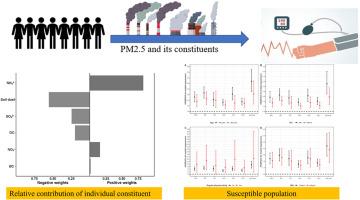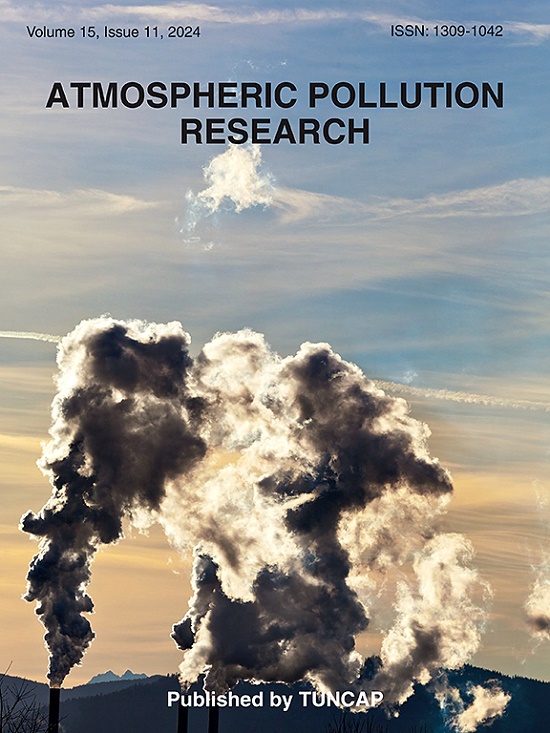Associations of long-term exposure to ambient PM2.5 and its constituents with risk of incident hypertension in rural China
IF 3.5
3区 环境科学与生态学
Q2 ENVIRONMENTAL SCIENCES
引用次数: 0
Abstract
We investigated the associations between long-term exposure to fine particulate matter (PM2.5) and its chemical constituents with the risk of incident hypertension in a prospective cohort of 17,380 adults from the Rural Deqing Cohort Study. Annual concentrations of PM2.5 and six major constituents were estimated using a satellite-based statistical model. Stratified Cox proportional hazard models were applied to evaluate the associations between pollutants exposure and hypertension incidence. Quantile-based g-computation was employed to assess the joint effects of PM2.5 constituents and determine their relative contributions. Over a mean follow-up period of 9.17 years, 4073 participants developed incident hypertension. Participants in the highest quartile of PM2.5 exposure had a significantly increased risk of hypertension compared to those in the lowest quartile (hazard ratio [HR]: 1.75; 95 % confidence interval [CI]: 1.51–2.03). Each 10-μg/m3 increase in PM2.5 was significantly associated with a 44 % higher risk of incident hypertension (HR:1.44; 95 % CI:1.31–1.59). Similar positive associations were observed for individual PM2.5 constituents. Among them, ammonium contributed the most to the overall mixture effect (82.9 %) among all individual constituent. Stronger associations were observed among men and younger adults. Our findings suggests that long-term exposure to ambient PM2.5 and its constituents, particularly ammonium, increases the risk of incident hypertension. Subpopulations including men and younger adults may be more susceptible to the adverse cardiovascular effect of air pollution.

中国农村地区长期暴露于环境PM2.5及其成分与高血压发病风险的关系
我们调查了长期暴露于细颗粒物(PM2.5)及其化学成分与发生高血压风险之间的关系,研究对象是来自德清农村队列研究的17,380名成年人。使用基于卫星的统计模型估算了PM2.5和六种主要成分的年浓度。采用分层Cox比例风险模型评估污染物暴露与高血压发病率之间的关系。采用基于分位数的g计算来评估PM2.5组分的联合效应,并确定它们的相对贡献。在平均9.17年的随访期间,4073名参与者患上了偶发性高血压。PM2.5暴露最高四分位数的参与者患高血压的风险显著高于暴露最低四分位数的参与者(风险比[HR]: 1.75;95%置信区间[CI]: 1.51-2.03)。PM2.5每增加10 μg/m3,发生高血压的风险就会增加44% (HR:1.44;95% ci: 1.31-1.59)。PM2.5的各个成分也观察到类似的正相关。其中,铵对整体混合效应的贡献率最大,为82.9%。在男性和年轻人中观察到更强的关联。我们的研究结果表明,长期暴露于环境PM2.5及其成分,特别是铵,会增加发生高血压的风险。包括男性和年轻人在内的亚人群可能更容易受到空气污染对心血管的不利影响。
本文章由计算机程序翻译,如有差异,请以英文原文为准。
求助全文
约1分钟内获得全文
求助全文
来源期刊

Atmospheric Pollution Research
ENVIRONMENTAL SCIENCES-
CiteScore
8.30
自引率
6.70%
发文量
256
审稿时长
36 days
期刊介绍:
Atmospheric Pollution Research (APR) is an international journal designed for the publication of articles on air pollution. Papers should present novel experimental results, theory and modeling of air pollution on local, regional, or global scales. Areas covered are research on inorganic, organic, and persistent organic air pollutants, air quality monitoring, air quality management, atmospheric dispersion and transport, air-surface (soil, water, and vegetation) exchange of pollutants, dry and wet deposition, indoor air quality, exposure assessment, health effects, satellite measurements, natural emissions, atmospheric chemistry, greenhouse gases, and effects on climate change.
 求助内容:
求助内容: 应助结果提醒方式:
应助结果提醒方式:


